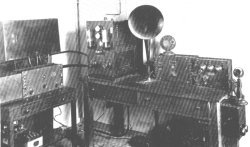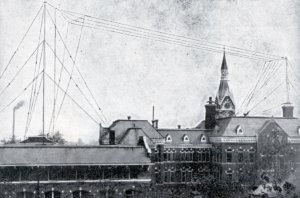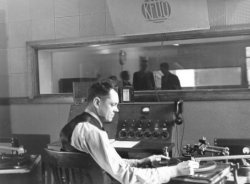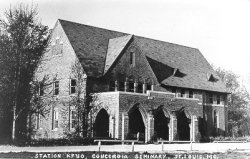Maybe it’s the fact that they don’t spend any money on tv commercials. You don’t see any bumper stickers containing their call letters. There’s that thing about their history, being owned by the same group since signing on in 1948. Oh, yes – They’re the oldest FM station in the market, and in the past two years, they’ve averaged a respectable 3.1 quarter hour 12+ share in Arbitron, delivering the kind of high-end demographics many advertisers crave. And then there’s the Marconi Award last year.
So why is it that when the “radio reporter” for the St. Louis Post-Dispatch writes a rambling, misinformed article on the lack of variety on the market’s music radio stations, she doesn’t even mention KFUO-FM? Doesn’t classical music count?
There is a uniqueness to Classic 99, including the fact that it’s still on the air, and still commercially successful. In the past few years, classical music stations in New York, Chicago, Miami, Detroit, Kansas City, Philadelphia and Denver have dropped the format, opting for something more popular – and more lucrative. Chicago Sun-Times Radio/TV columnist Robert Feder tells SJR his city once enjoyed “two full-time commercial classical music stations.” When big money came calling, the married couple who owned WNIB (having put it on the air for $8,000 45 years ago) sold for $165 million. Exit classical music; enter rock music.
Philadelphia saw the same thing happen. Kent Steinriede, who writes for the Philadelphia Weekly, says “WFLN was bought by a big radio chain that dropped the [classical] format because it didn’t pay.” It’s a rock station now, and the City of Brotherly Love can only hear classical music during a limited number of hours each day on the Temple University station.
Here in St. Louis, that situation was reversed. In 1994 the non-commercial radio station owned by the University of Missouri – St. Louis dropped its broadcasts of classical music, thereby giving KFUO-FM a sort of classical monopoly. At Classic 99, they’ve been running commercials since 1983, and although they provide a significant chunk of income to their owners from spot sales, there’s a slight difference in their operating philosophy when compared to other commercial stations.
In St. Louis, KFUO-FM is owned by the Lutheran Church – Missouri Synod, and the station’s director of broadcast, Dennis Stortz, says that gives the station a big advantage over those that were sold. “The mission of the station is really two-fold: to support the cultural well-being of the community and to represent its ownership in that quest. Broadcast groups search endlessly for the right format. This is a traditional format and people respect it.”
It appears the Lutheran Church is one of those “old-fashioned” radio owners that cares very deeply about serving the community. The station works hard at publicizing the entire St. Louis Arts community. They’ve established outreach programs to take music into the schools, provide musical instruments to students, and give disadvantaged kids a chance to perform the music they’ve learned. Dennis Stortz admits there’s no way to please all the listeners. “In 1990 or 91, it became apparent we had to start giving the audience a format based largely on the popular classics.” The result was a load of letters from an audience segment upset that they were no longer hearing entire orchestral works. Stortz says the jump in audience levels was significant the audience has stayed. The format also includes CNN news broadcasts during morning and afternoon drive and regular reports from the Wall Street Journal when the markets are open.
KFUO-FM’s uniqueness in the radio business extends beyond format and community service. “Our full-time staff hasn’t changed in any dramatic way in the past ten years,” says Stortz. Morning man Jim Connett has been there for 10 years; John Roberts, who holds down middays has been an announcer there since 1977; Dick Wobbe, who is in afternoon drive has been on the air at Classic 99 since 1985; and operations director Ron Klemm, whose voice is on many commercials an most of the station’s weekly specialty shows, has been there for 23 years.
Everyone at the station agrees there’s a special relationship between Classic 99 and its listeners. Afternoon announcer Dick Wobbe puts it succinctly: “I think the people who listen to us realize our station is something special.” And Dennis Stortz says staff members are appreciative of their relationship with the listeners: “We spend a lot of time each day answering emails from our audience. They listen. They respond. We never have remotes where people don’t show up.”
Staff members agree the two-way listener-station relationship is based, in part, on the musical product. Jim Connett, who is also the station’s program director, says, “People come here for the music. It’s their [listeners’] radio station.” And Ron Klemm says the listeners’ taste is due to their demographic backgrounds: “Classical music people are more educated, are more involved in the community. There is a connection with the listener that is so intimate that each of them has a sense of ownership in what we’re doing.”
One man, Paul DeVantier, has a perspective of the radio station that is unique. Now retired and living in Wisconsin, he served as general manager of the station for many years before moving to the position of Executive Director of Communications for the synod.
DeVantier says over that 28 year period, he saw a “leadership in the synod committed to classical music as its most appropriate use of the airwaves, because it tied in with the Lutheran understanding of the importance of music in life itself.”
Thanks to the Telecommunications Act of 1996, there’s really no limit on the number of radio stations a company can own. Because of that four corporations own the bulk of the nation’s radio properties, and the days are gone when the corporate executives knew the names of the people who worked for them. That is, they’re gone almost everywhere. At KFUO-FM in the nation’s seventeenth largest radio market, the staff is well known to the owners, and to the station’s many listeners.
(Reprinted with permission of the St.Louis Journalism Review. Originally published 04/01)





